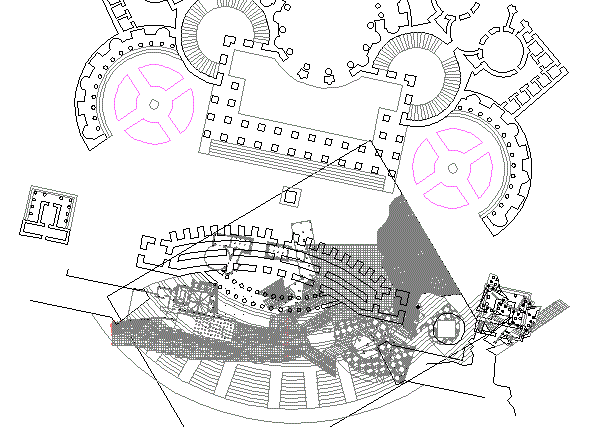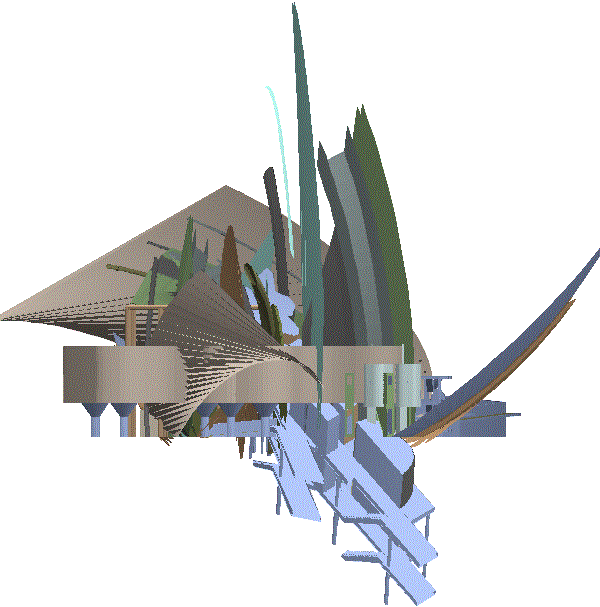2001.09.21 16:09
Re: travels in hyper-reality
Theming comes in many, many varieties, of which the sanitized version is only a subset of general theming. Theming, like theater, however, is a subset of reenactment.
In the United States of America we celebrate Thanksgiving Day the last Thursday of November. Virtually every family in the USA has a turkey dinner with all the trimmings on that day. This dinner is a reenactment of a supposed dinner the Pilgrims and the Indians shared at one of the first harvests of the new settlers in America. Is the modern day Thanksgiving Dinner in the USA an authentic reenactment? It's probably more an artificial reenactment, yet, nonetheless, it is now also as authentically 'American' as any dinner can get.
At this point, I'm seriously wondering whether the specialness of reenactment is that it combines both the authentic and the artificial. For example, authentic Chinatowns (like the one in Philadelphia) are full of artificial, albeit unsanitized, theming. Yet for the generations of Chinese citizens living there, it is their reenactment of 'home'.
2001.09.24 10:56
Re: travels in hyper-reality
Maybe I'm completely off base here, but my experience of most academic studies of the environment is that they are as sanitized as the most purposefully themed environments. I often get the feeling that academic studies very much strive to control what the reader perceives, and often leave little room for alternative preceptions. It's kind of ironic that the more controlled a themed environment is, the more it lacks authenticity, while the more controlled an analysis of themed environments is, the more controlled the perception of themed environments remains.
I wonder if one could analyze themed environmental studies to find which are more artificial and which are more authentic.
2001.09.28 10:41
Re: travels in hyper-reality
I find it highly ironic that the movie Suburbia is first and foremost a piece of entertainment, moreover, a piece of entertainment that reenacts what is considered "gritty reality [i.e., authenticity] of youth alienation from the dreary suburban gravity of small town living in the mid-nineties." It seems that "learning from" Suburbia is itself "a symptom of our social preoccupation with the entertaining experience."
If anything, architects and designers and social engineers should begin to understand the pervasive workings of reenactment in order to start generating a 'better' learning/entertainment environment. The largest themed environments today are for the most part fantasy reenactments, and for the most part the general public is completely aware of the fantasy. That the fantasy is many times also so real, only adds to the appeal. Again, the issue is the blurring of distinction between what is real and what is artificial, and therein lies the further fulfilling of fantasy, a longed for fulfillment which may indeed engender the very core of the desire for entertainment.
Reenactment has been a integral part of architecture and design for at least 4500 years. The Great Pyramid is a massive reenacted mountain that fits perfectly on Earth via its alignment with the cardinal points, and with its quondam capping of electrum (an alloy of platinum, gold, and (I think) silver) this mountain further reenacted both a volcano and the sun rising and setting over the mountain. When new, the Great Pyramid at Giza very much manifested an artificial and themed environment, and for sure was one of the most entertaining sights/sites that has ever appeared on this planet.
| |
2001.10.23
Re: chance aesthetics experience
How does one gauge 'hyper-size'?
Beginning with the premise that scale is always an issue of relativity, ie, the direct comparison of one 'measure' to another 'measure', it is interesting that you relate the canopy both to its immediate surroundings (the buildings the canopy is connected to) and to yourself as well. In both cases you see the scale of the canopy as comfortable, even though a common canopy is usually in direct relation to a door or window (as opposed to a whole building), and furthermore an architectural element that can often be touched by an individual (as opposed to being untouchably high up in the sky). The gauges of scale you utilized were the adjacent buildings and your own corporal being, and these gauges are pretty much the best gauges of the environment we have.
In terms of then gauging "hyper-size" (ie, in terms of hyper meaning beyond, excessive, etc.), the comparison is (or at least seems to be) between what is usual next to an inflated example of the same something usual. In the case of the Calatrava canopy, it appears that you do not see it as over-inflated, and here I trust your judgement. If anything, you may have thus provided a good gauge of something hyper-sized that is not overhyped, while at the same time indicating that there may indeed be a thin line between "wondrous" and "overwhelming".
Personally, I have a feeling that sheer materiality itself serves as the best gauge of what is overhyped-sized. For example, the (Gothic) Cathedral of Bauvais was to be the largest Cathedral in the world, and indeed still contains the highest stone arch in the world. Its tower (at 500 feet) too was once the tallest building in the world, in fact it was the first building anywhere to exceed the height of the Great Pyramid of Giza (at 480 feet). Unfortunately, the tower collapsed (circa 1575?) about 75 years after its erection. Maybe its too simple, but reality nonetheless "points" to the fact that the Great Pyramid is the hyper-size gauge when it comes to pure masonry construction.
In light of the horrific events of 11 September 2001, it appears that the two World Trade Center Towers were also of an overhyped-size.

011024a
| |
2001.10.28 11:35
husker du?
Quondam design-l lister Rick McBride sent me a link to yesterday's NYTIMES article "A Memorial Is Itself a Shaper of Memory" which muses on the future fate of the World Trade Center site. Rick wondered if the article might relate to reenactment and architecture. Here's how I responded:
While human memory itself is very likely the prototype of all reenactment, memorials themselves are not necessarily manifestations of reenactionary architecturalism. Keeping and displaying the ruins of the World Trade Center towers is not an act of reenactment. Rebuilding the towers, each up to the height of 9/11 impact, each with a gigantic staircase spiraling down, and each filled with a core of places of prayer and worship (with a mosque at each acme), would be reenactionary architecturism, especially for pilgrims that fly (via helicopters) to the tops and then walk all the way down.
2001.10.28
HyperHouses

01112508
|